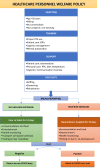Multidimensional dynamic healthcare personnel (HCP)-centric model from a low-income and middle-income country to support and protect COVID-19 warriors: a large prospective cohort study
- PMID: 33619195
- PMCID: PMC7902325
- DOI: 10.1136/bmjopen-2020-043837
Multidimensional dynamic healthcare personnel (HCP)-centric model from a low-income and middle-income country to support and protect COVID-19 warriors: a large prospective cohort study
Abstract
Objectives: Healthcare personnel (HCP) are at an increased risk of acquiring COVID-19 infection especially in resource-restricted healthcare settings, and return to homes unfit for self-isolation, making them apprehensive about COVID-19 duty and transmission risk to their families. We aimed at implementing a novel multidimensional HCP-centric evidence-based, dynamic policy with the objectives to reduce risk of HCP infection, ensure welfare and safety of the HCP and to improve willingness to accept and return to duty.
Setting: Our tertiary care university hospital, with 12 600 HCP, was divided into high-risk, medium-risk and low-risk zones. In the high-risk and medium-risk zones, we organised training, logistic support, postduty HCP welfare and collected feedback, and sent them home after they tested negative for COVID-19. We supervised use of appropriate personal protective equipment (PPE) and kept communication paperless.
Participants: We recruited willing low-risk HCP, aged <50 years, with no comorbidities to work in COVID-19 zones. Social distancing, hand hygiene and universal masking were advocated in the low-risk zone.
Results: Between 31 March and 20 July 2020, we clinically screened 5553 outpatients, of whom 3012 (54.2%) were COVID-19 suspects managed in the medium-risk zone. Among them, 346 (11.4%) tested COVID-19 positive (57.2% male) and were managed in the high-risk zone with 19 (5.4%) deaths. One (0.08%) of the 1224 HCP in high-risk zone, 6 (0.62%) of 960 HCP in medium-risk zone and 23 (0.18%) of the 12 600 HCP in the low-risk zone tested positive at the end of shift. All the 30 COVID-19-positive HCP have since recovered. This HCP-centric policy resulted in low transmission rates (<1%), ensured satisfaction with training (92%), PPE (90.8%), medical and psychosocial support (79%) and improved acceptance of COVID-19 duty with 54.7% volunteering for re-deployment.
Conclusion: A multidimensional HCP-centric policy was effective in ensuring safety, satisfaction and welfare of HCP in a resource-poor setting and resulted in a willing workforce to fight the pandemic.
Keywords: clinical governance; health & safety; health policy; human resource management; international health services; organisation of health services.
© Author(s) (or their employer(s)) 2021. Re-use permitted under CC BY-NC. No commercial re-use. See rights and permissions. Published by BMJ.
Conflict of interest statement
Competing interests: None declared.
Figures




Similar articles
-
Assessing coronavirus disease 2019 (COVID-19) transmission to healthcare personnel: The global ACT-HCP case-control study.Infect Control Hosp Epidemiol. 2021 Apr;42(4):381-387. doi: 10.1017/ice.2020.455. Epub 2020 Sep 9. Infect Control Hosp Epidemiol. 2021. PMID: 32900402 Free PMC article.
-
Beyond the PPE shortage: Improperly fitting personal protective equipment and COVID-19 transmission among health care professionals.Hosp Pract (1995). 2020 Dec;48(5):246-247. doi: 10.1080/21548331.2020.1802172. Epub 2020 Aug 11. Hosp Pract (1995). 2020. PMID: 32713215
-
Frontline healthcare workers' experiences with personal protective equipment during the COVID-19 pandemic in the UK: a rapid qualitative appraisal.BMJ Open. 2021 Jan 20;11(1):e046199. doi: 10.1136/bmjopen-2020-046199. BMJ Open. 2021. PMID: 33472794 Free PMC article.
-
Operating Room Setup: How to Improve Health Care Professionals Safety During Pandemic COVID-19-A Quality Improvement Study.J Laparoendosc Adv Surg Tech A. 2021 Jan;31(1):85-89. doi: 10.1089/lap.2020.0592. Epub 2020 Aug 14. J Laparoendosc Adv Surg Tech A. 2021. PMID: 32804047 Review.
-
Personal Protective Equipment for Endoscopy in Low-Resource Settings During the COVID-19 Pandemic: Guidance From the World Gastroenterology Organisation.J Clin Gastroenterol. 2020 Nov/Dec;54(10):833-840. doi: 10.1097/MCG.0000000000001411. J Clin Gastroenterol. 2020. PMID: 32909973 Review.
Cited by
-
Barriers and enablers of breastfeeding in mother-newborn dyads in institutional settings during the COVID-19 pandemic: A qualitative study across seven government hospitals of Delhi, India.Front Nutr. 2022 Dec 8;9:1052340. doi: 10.3389/fnut.2022.1052340. eCollection 2022. Front Nutr. 2022. PMID: 36570141 Free PMC article.
-
Willingness to Work during Public Health Emergencies: A Systematic Literature Review.Healthcare (Basel). 2022 Aug 9;10(8):1500. doi: 10.3390/healthcare10081500. Healthcare (Basel). 2022. PMID: 36011158 Free PMC article. Review.
-
Doffing Corridor: Establishing Expedited High-Volume Doffing With Exposure Reduction to Contaminated Personal Protective Equipment (PPE) in a COVID-19 Hospital in India.Cureus. 2023 Feb 27;15(2):e35529. doi: 10.7759/cureus.35529. eCollection 2023 Feb. Cureus. 2023. PMID: 37007376 Free PMC article.
-
Multipronged strategy for protection and motivation of healthcare workers during the COVID-19 pandemic: a real-life study.Antimicrob Steward Healthc Epidemiol. 2024 Jul 25;4(1):e101. doi: 10.1017/ash.2023.459. eCollection 2024. Antimicrob Steward Healthc Epidemiol. 2024. PMID: 39823119 Free PMC article.
-
Human resource management (HRM) strategies of medical staff during the COVID-19 pandemic.Heliyon. 2023 Sep 21;9(10):e20355. doi: 10.1016/j.heliyon.2023.e20355. eCollection 2023 Oct. Heliyon. 2023. PMID: 37771528 Free PMC article. Review.
References
-
- WHO WHO Dashboard, 2020. Available: https://www.who.int/redirect-pages/page/novel-coronavirus-(COVID-19)-sit...
-
- Government of India COVID-19 statewise status, 2020. Available: https://www.mygov.in/COVID-19
MeSH terms
LinkOut - more resources
Full Text Sources
Other Literature Sources
Medical
Miscellaneous
